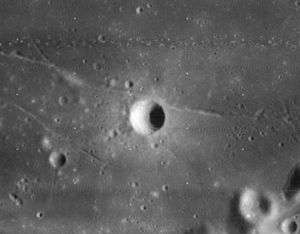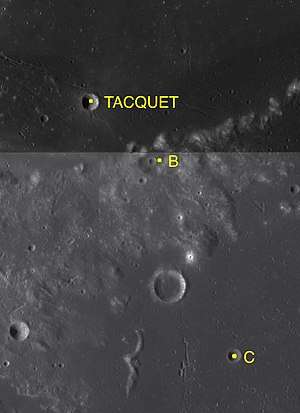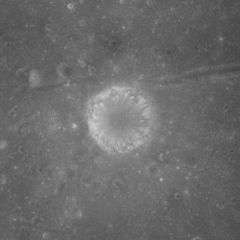Tacquet (crater)
 Lunar Orbiter 4 image | |
| Coordinates | 16°36′N 19°12′E / 16.6°N 19.2°ECoordinates: 16°36′N 19°12′E / 16.6°N 19.2°E |
|---|---|
| Diameter | 7 km |
| Depth | 1.3 km |
| Colongitude | 340° at sunrise |
| Eponym | André Tacquet |
Tacquet is a small, bowl-shaped crater that lies near the southern edge of Mare Serenitatis, in the northeast part of the Moon. The surface near the crater is marked by high-albedo ejecta. To the west is a system of rilles designated the Rimae Menelaus, southeast is al-Bakri crater (or Al-Bakri) about 65 km southeast, about 60 km WSW is Auwers crater and nearly 80 km west is the larger Menelaus crater.
Its diameter is 7 km long and is 1,300 meters deep. The area is about 30 to 35 km² and the perimeter is about 20 km.
Names
Some sources spell this crater's name 'Taquet'. The name was given in the honor of Belgian mathematician André Tacquet (1612-1660). Before the 1651 nomenclature, there was a crater named "Tacquet" mentioned in Michael van Langren's 1645 map and was written as "Tacquetti" (Latin: "Tachettis").[1] Its location was what is now Laplace A, the other is now known as Helicon.
Satellite craters


By convention these features are identified on lunar maps by placing the letter on the side of the crater midpoint that is closest to Tacquet.
Tacquet B is to the southeast 14 km in diameter, inside is a smaller crater covering about a quarter of the diameter and is being a double crater. Further south-southeast is Tacquet C that is 6 km in diameter.
| Tacquet | Latitude | Longitude | Diameter |
|---|---|---|---|
| B | 15.8° N | 20.0° E | 14 km |
| C | 13.5° N | 21.1° E | 6 km |
The following craters have been renamed by the IAU.
- Tacquet A — See Al-Bakri (crater).
References
- ↑ Langren, Michael van (1645). "Map of the Moon in the book Plenilunii lumina Austriaca Philippica".
- Andersson, L. E.; Whitaker, E. A. (1982). NASA Catalogue of Lunar Nomenclature. NASA RP-1097.
- Blue, Jennifer (July 25, 2007). "Gazetteer of Planetary Nomenclature". USGS. Retrieved 2007-08-05.
- Bussey, B.; Spudis, P. (2004). The Clementine Atlas of the Moon. New York: Cambridge University Press. ISBN 978-0-521-81528-4.
- Cocks, Elijah E.; Cocks, Josiah C. (1995). Who's Who on the Moon: A Biographical Dictionary of Lunar Nomenclature. Tudor Publishers. ISBN 978-0-936389-27-1.
- McDowell, Jonathan (July 15, 2007). "Lunar Nomenclature". Jonathan's Space Report. Retrieved 2007-10-24.
- Menzel, D. H.; Minnaert, M.; Levin, B.; Dollfus, A.; Bell, B. (1971). "Report on Lunar Nomenclature by the Working Group of Commission 17 of the IAU". Space Science Reviews. 12 (2): 136–186. Bibcode:1971SSRv...12..136M. doi:10.1007/BF00171763.
- Moore, Patrick (2001). On the Moon. Sterling Publishing Co. ISBN 978-0-304-35469-6.
- Price, Fred W. (1988). The Moon Observer's Handbook. Cambridge University Press. ISBN 978-0-521-33500-3.
- Rükl, Antonín (1990). Atlas of the Moon. Kalmbach Books. ISBN 978-0-913135-17-4.
- Webb, Rev. T. W. (1962). Celestial Objects for Common Telescopes (6th revised ed.). Dover. ISBN 978-0-486-20917-3.
- Whitaker, Ewen A. (1999). Mapping and Naming the Moon. Cambridge University Press. ISBN 978-0-521-62248-6.
- Wlasuk, Peter T. (2000). Observing the Moon. Springer. ISBN 978-1-85233-193-1.
| Wikimedia Commons has media related to Tacquet (crater). |